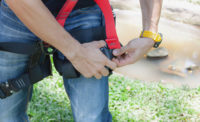Falls still leading cause of death in construction industry

It’s no secret that falls are the leading cause of death in the construction industry. It’s critical you emphasize and address fall hazards on your worksite. According to the Bureau of Labor Statistics, in 2018, there were 320 fatal falls to a lower level out of 1,008 construction fatalities.
To prevent these types of fatalities, OSHA’s construction fall protection standard at 29 CFR 1926 Subpart M provides numerous options to choose from to help you protect your employees. Ultimately, the Agency’s requirements allow you to take advantage of various fall protection systems (or a combination of systems) to implement in your workplace.
While the information above is helpful, it doesn’t necessarily help solve the issue. Let’s take a look at four common areas where construction work proves to be most dangerous:
- Unprotected sides and edges,
- Overhand bricklaying and related work,
- Roof work on low-slope roofs, and
- Holes.
Unprotected sides and edges
Protect employees when they are exposed to falls from unprotected sides and edges of walking/working surfaces (horizontal and vertical surfaces) which are six feet or more above lower levels. There are three types of conventional fall protection systems you can implement:
- Guardrail systems
- Safety net systems
- Personal fall arrest systems
Whatever system you use, OSHA expects that you implement it early in the construction process.
Note: It’s important you maintain the system in place until all work is completed — or until the permanent elements of the structure which will eliminate the exposure to falling hazards are in place.
When you have employees on walking/working surfaces where leading edges are under construction, but who are not constructing the leading edge, they must also be protected from a fall by the same systems listed above.
If you choose a guardrail system, and a controlled access zone has already been established for leading edge work, the control line may be used instead of a guardrail along the edge that parallels the leading edge.
Overhand bricklaying
Overhand bricklaying is a job many of you probably oversee on a day-to-day basis. OSHA’s standard allows you to protect employees from the hazards of this work in a few different ways including:
- Guardrail systems,
- Personal fall arrest systems,
- Safety net systems, or
- Controlled access zones.
Note: Some of you may be wondering about overhand bricklaying work on scaffolds. The Agency regulates those requirements under 1926 Subpart L.
Holes
Holes are a common hazard employees in all industries face. However, especially during construction work, employees can be injured or even killed if they step into holes, trip over holes, fall through holes, or are hit by objects falling through holes.
Employees on walking/working surfaces must be protected from falling into or through holes (including skylight openings) six or more feet above lower levels by:
- Installing a cover over the hole,
- Erecting a guardrail system around the hole, or
- The use of a personal fall arrest system.
OSHA does not intend that a guardrail be erected around holes while employees are working at the hole or passing materials through it. If the cover is removed while work is in progress, guardrails are not required because they would interfere with the performance of work. When the work has been completed, the employer is required to either replace the cover or erect guardrails around the hole.
Roofing work on low-slope roofs
Protect employees when they are performing roofing activities on low-slope roofs with unprotected sides and edges six feet or more above lower levels. Your options are:
- Guardrail systems,
- Safety net systems,
- Personal fall arrest systems, or
- A combination of:
- Warning line and guardrail systems,
- Warning line and safety net systems,
- Warning line and personal fall arrest systems, or
- Warning line safety monitoring systems (on roofs 50 feet or less in width).
As you can see, there are various options available to protect your employees from fall hazards on the construction jobsite. Select and implement the ones that work best for your situation and give your employees the safe work environment they deserve.
Key takeaways and training requirements
Unsafe environment, equipment, and employee behavior are all factors that can contribute to injury or death on the job. That’s why OSHA stresses the importance of shoring up fall protection hazards before you begin work.
Equally important is your duty to provide training to prevent the worst from happening. All employees who may be exposed to fall hazards must be trained on how to recognize and minimize them.
Keep top of mind, you must provide training (when applicable) on:
- Fall protection hazards that exist on your jobsite,
- How to properly report issues with existing fall protection, and
- How to correctly use, operate, install, maintain, dismantle, and inspect fall protection systems.
Depending on the situation, such as a change in the workplace or in the type of fall protection used, you may need to retrain employees. Finally, OSHA requires employers to prepare a written certification record after the training is completed.
Looking for a reprint of this article?
From high-res PDFs to custom plaques, order your copy today!





